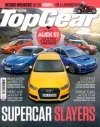Moke On The Water
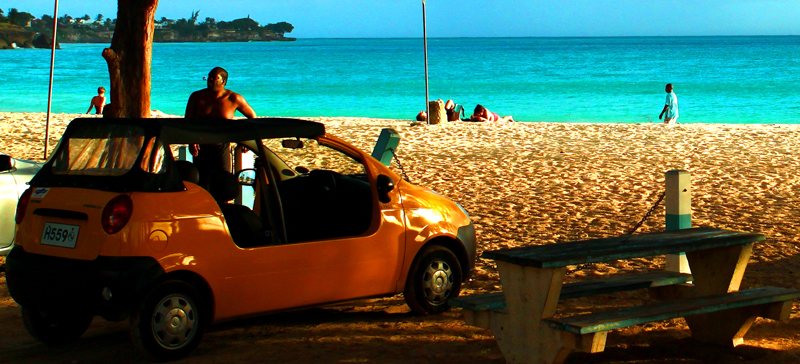
Do you get the feeling these days that you’re being taken for a ride by your own car, its electronic controls navigating you wherever they deem fit? Do you feel that the modern car is all about safety and risk prevention instead of an unrestrained driving experience, despite the promise of the open road offered in glossy magazine ads of rugged cars pioneering through a photoshopped wilderness?
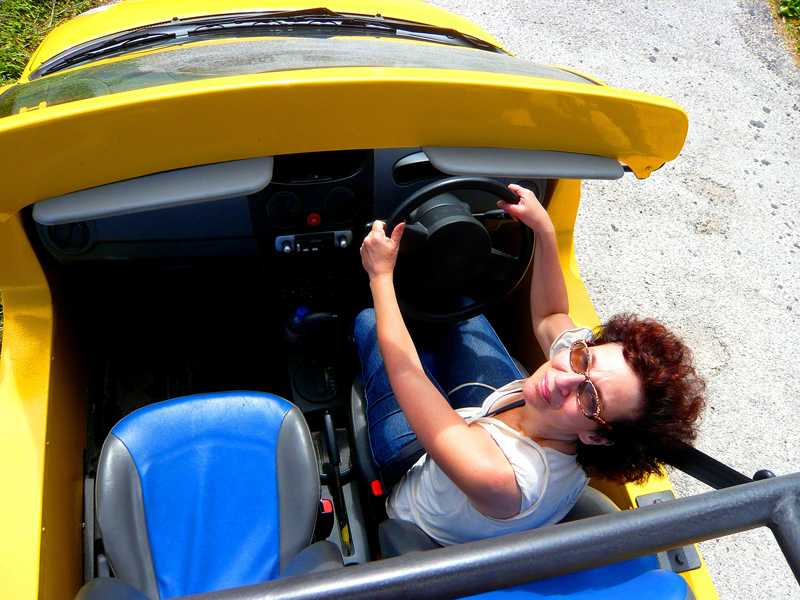
Are you ready to come out of your automotive cocoon?
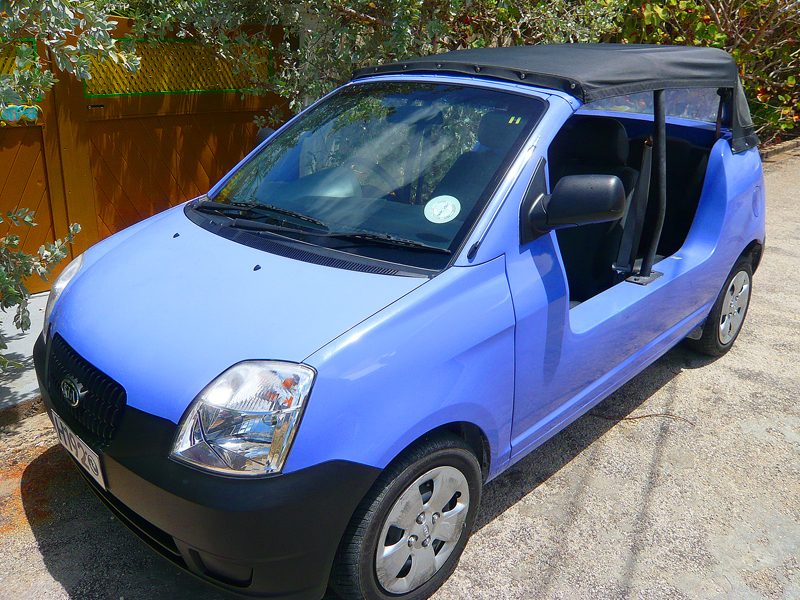
If yes, you can book a flight to Barbados and immerse yourself in a bare-bones stunt that’s off limits in safety- and comfort-conscious Europe and North America. Just head for the desk at one of the rental car pavillions outside the airport doors—Stoutes and Drive-A-Matic are two of the big ones—and ask for the keys to a ‘Moke.’* You’ll get the island’s own couturier version of that rock-and- rolling beach chair blueprinted decades ago. Its a Vivienne Westwood shell, with fresh internals from KIA, Daewoo and the like (basically, whatever subcompact comes to hand) sitting on a cut-to-size, cut-out modern frame. No pimping of the retro look in the vein of BMW’s Mini reincarnation here.
And hip it is, not hip replacement, to climb into this Moke.
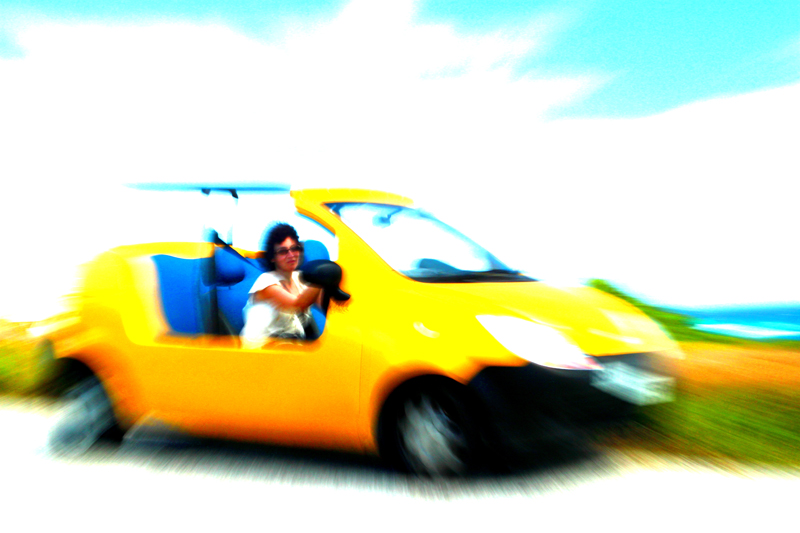
Cruising along the ocean and racing inland through hilly terrain, you’re in touch with the elements at all times, airborne one moment, amphibious the other. Sunshine or rain. Wet tarmac is instant karma. Just because these Chinese-made tires are round doesn’t mean they have any grip. So enjoy the wagging tail in sharp bends. And never mind the rain pouring in. There is no carpeting or sound-deadening; the floor is just that--a metal bottom tray with drain holes. Look down and you can watch the road zipping by with the puddles trying to lash in.
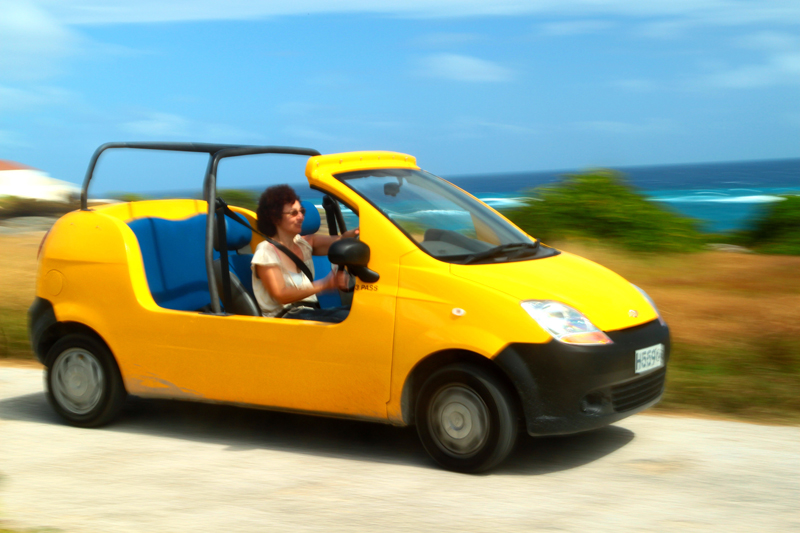
Battered, beach-weathered roads let the Moke go rodeo. It needs a sturdy hand on the wheel and a stoic mindset not to worry that something might fall off (including your passenger). It won’t. Not even at higher speeds, which translates for the Moke into some 50 or 60mph and then some, if you really try hard. The detachable canvas top stays put thanks to snaps, believe it or not. It protests, though, with ear deafening flapping. But don’t even think about pushing above 80, with horsepower options maxed out in the lower 60hp’s. More adrenaline is, however, available after peeling off the head-cover. To cope with the ensuing tornado just put on a pair of shades; any other headgear will fly off instantly. And don’t be surprised if a pebble flips into your lap.
Beachcombers and others in search for someplace secluded--to store valuables that is--are offered a lockable trunk with disabled folding seats, preventing sneaking in the other way. Speaking of protection, since there are effectively no doors, the side sills have been pulled upward waist-high, sporting internal tubular reinforcements, the only shield against love bites from a nasty competitor.
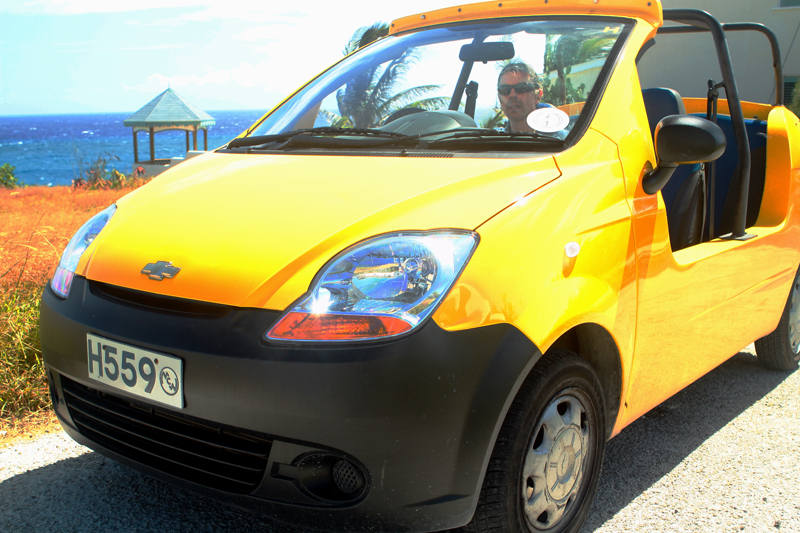
Now, the roll cage is really a matter of street smart thinking: Climb the high sill and you’re in for a nasty head-banger. So, don’t do a cage all the way from the front but start at the B-pillar back. That’s it. In case you roll-over simply trust the windshield frame to join in for support.
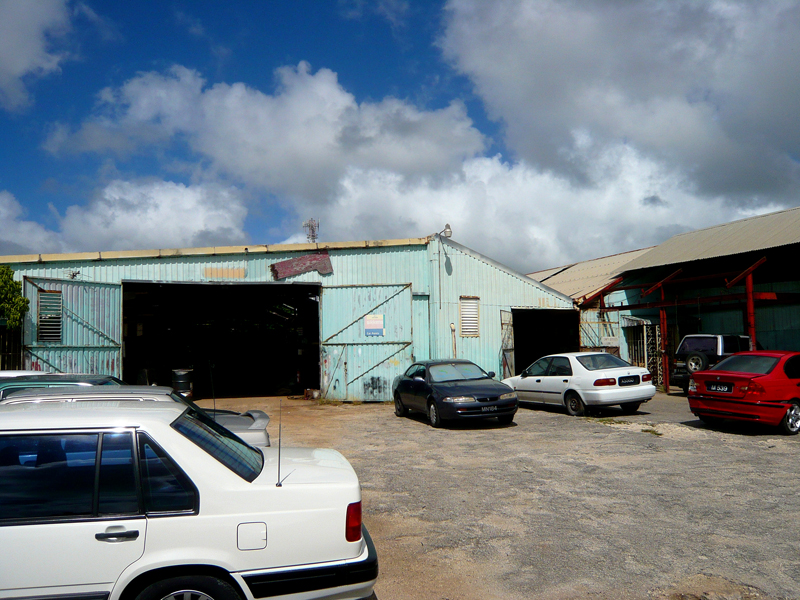
And where are these Mokes born? Well, right on the island, in a commercial zone near the town of Warrens. Apparently the local Authority consider road signs uncool, so it takes a bit of navigational free-style to find the place. Once in sight you can’t suppress a sigh of heartfelt relief, not because you finally made it, but because the place looks like it has survived the last bomb raid successfully after all, with only the company logo missing. This multicolored hangar in corrugated steel houses a wild panopticon of automotive carcasses in various stages of hope. Pigeons flutter in and out of impromptu skylights as a mechanic reattaches a dashboard. It’s specialized as body shop only, so Moke conversions fit in neatly.
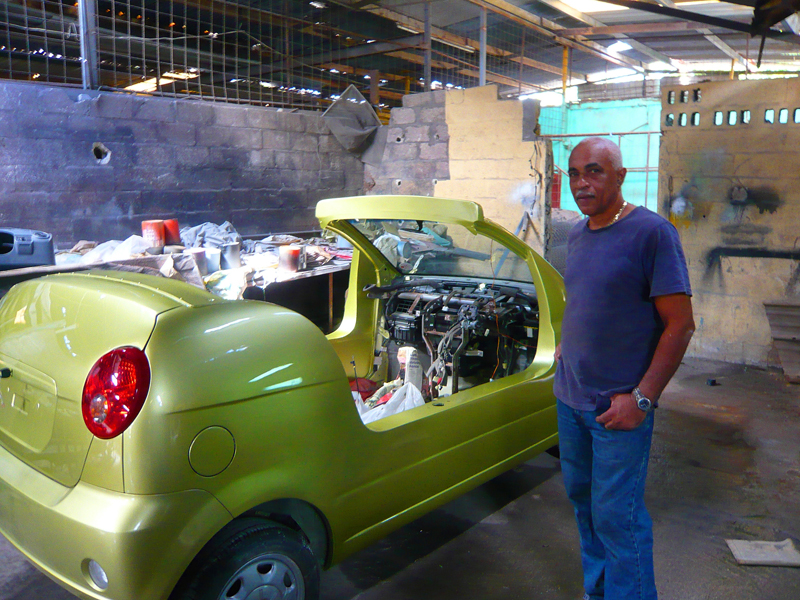
Proudly standing next to an open air reassigned Moke-in-progress, in jeans and T-shirt, soft-spoken but hard-nosed owner and entrepreneur James Edwards (also known as Paddy) is running down the specs: Bring in a city-car size runner like KIA’s Picanto or Daewoo/Chevrolet’s Spark, and for US $3,500 in 3 weeks time the conversion will be done. The patients can be brand new or weathered, it's okay either way. This is not a mass production, though, and the turn-out is, let’s say, rather exclusive. Privateers do exist, but the bulk is done for the local rental companies. A question about regulations and paperwork necessary for making the cars street legal gets answered with a blank look. So be clear, with the lack of official safety regulations, your driving life depends on his hands.
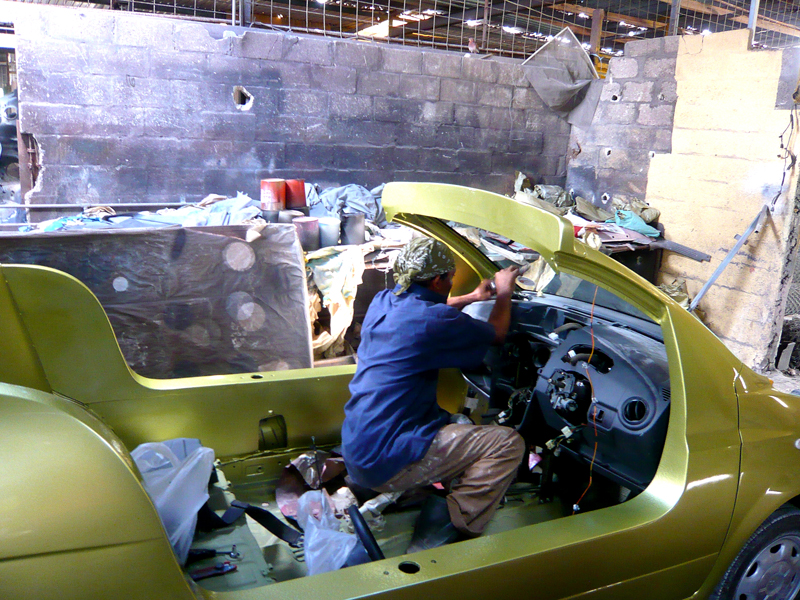
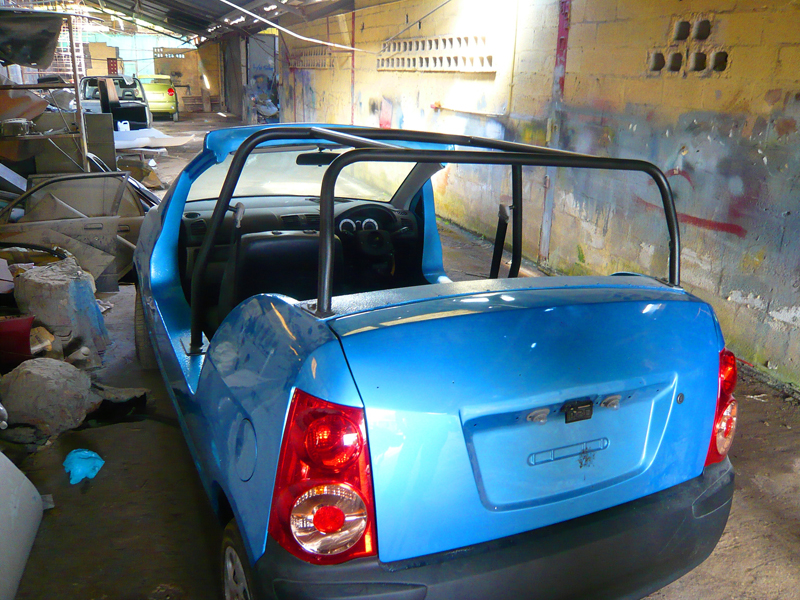
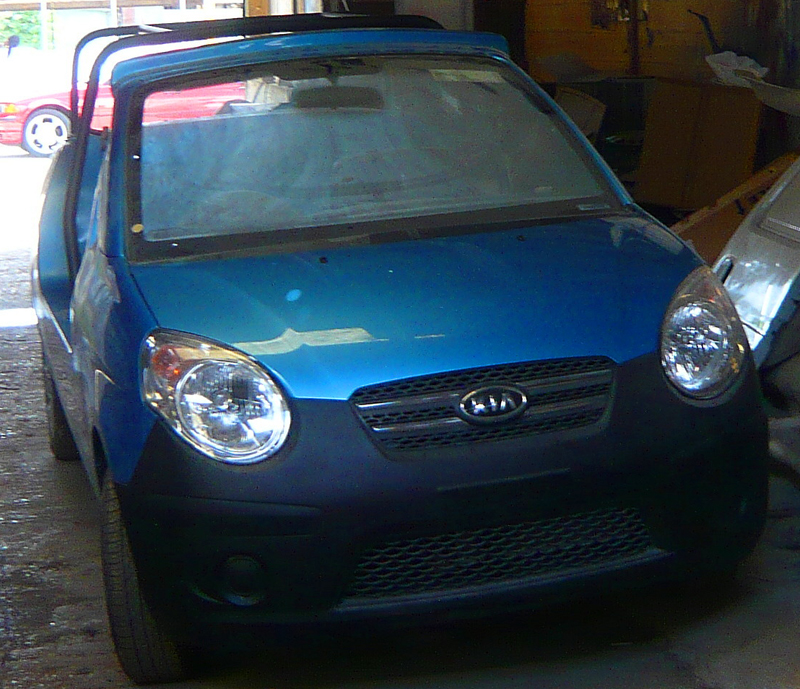
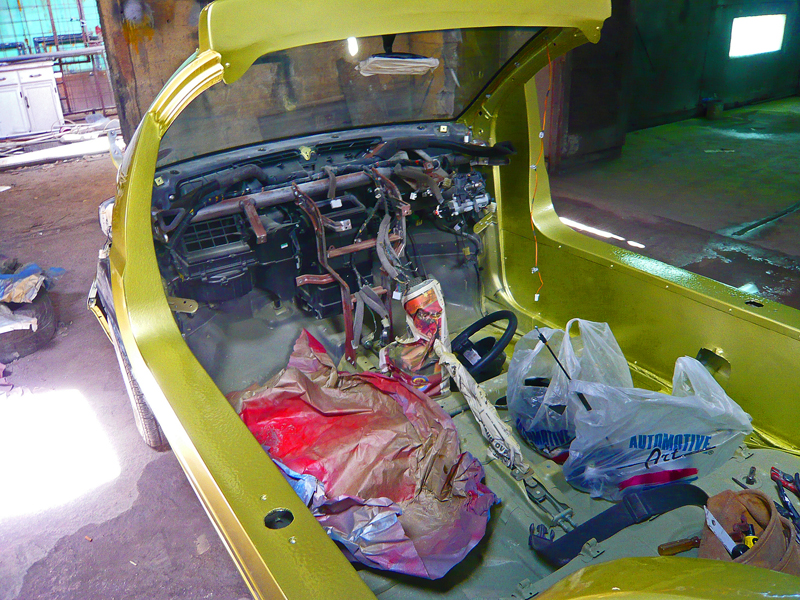
Is there any competition? “They’ve tried ... “ Edwards growls. The air of entitlement comes with a backdrop of 40 years or so in the business, and details like starting off big with the elephants of the trade--buses, developing the rental car company clientele, keeping after his workers, paying off the mortgage, and basically working really hard to sew up this niche market.
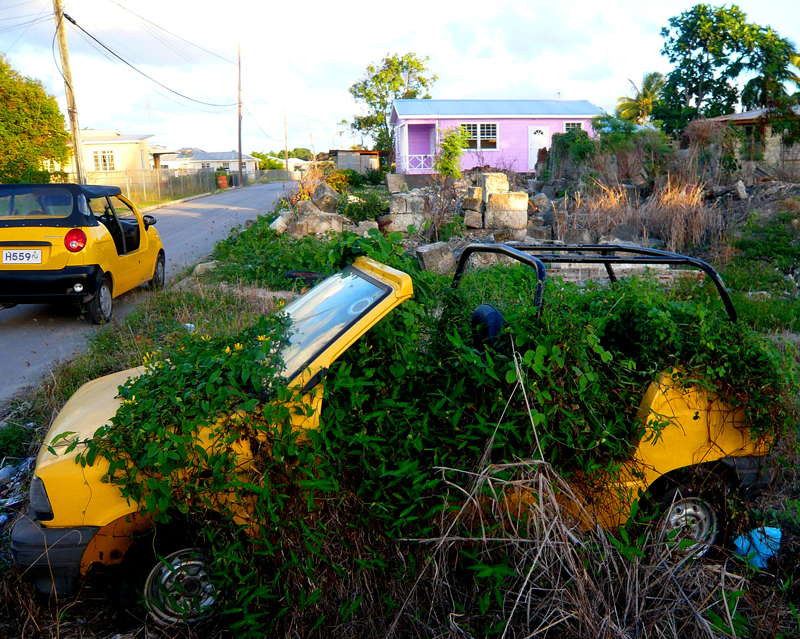
Finally, what’s the shelf life of one of these hard-driving, hard-partying cars? Not long. Stoutes retire a Moke after a year of servicing drive-starved tourists. Drive-A-Matic pushes their fleet a little longer. As no local Bajans would subject themselves to the indignities of driving a Moke for the long haul, you might wonder where the Mokes go to die. Well, driving up to the Emerald City Supermarket up at Six Roads, you will find an end-stage Moke unwittingly turned into a planter in an abandoned lot.
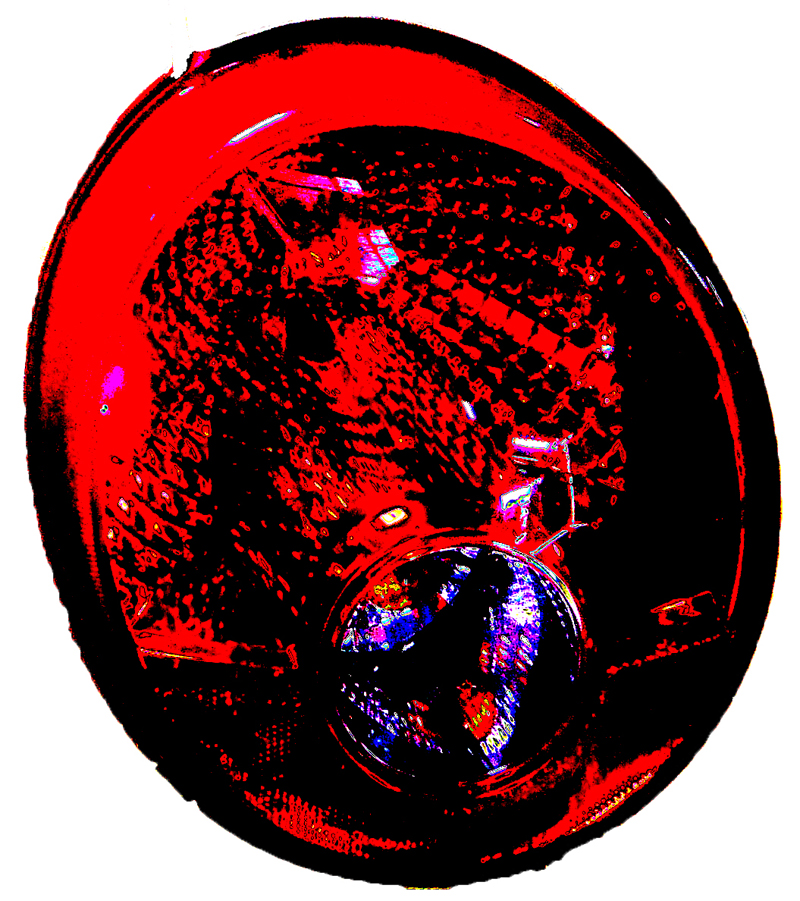
* The original, jeep-like Moke was a British Motor Corporation product of the 60s, entirely based on the Mini and its components and originally intended for light military purpose – believe it or not.
Original Manufacturer Literature: VW/AUDI's ERWIN and ETKA
If you want to achieve something special you have to, ultimately, take things into your own hands, educate yourself and put it into praxis. Despite the fact that a whole variety of car tech literature is out there, much of the cutting edge knowledge that is needed to solve a concrete problem successfully - and possibly even better than the official company support network ever could - is located in an "insider" field only. Some of it is acquired on the job and passed on orally, never written up or published. This experience and routine knowledge is just floating around like an "unspoken law". Other stuff is out there, but often in obscure or proprietary sites.
I will be posting periodically with niche sources and gathered info, to help bridge the knowledge gap. The list below provides prime links to fundamental OEM tech info for VW/Audi, which for me is closest to home (with other makes to follow):
- ERWIN (www.erwin.volkswagen.de) is VW/Audis’s own Electronic Repair and Workshop INformation service. It’s basically an online subscription and non-proprietary: you only have to register. The material that is available is essentially identical with what the dealerships are getting for their staff training (online and in seminars). It’s especially the first choice if information for a brand new model is needed. Publishers like Robert Bentley are obviously much slower, if they cover the model at all. ERWIN’s homepage is in English, their documents— well..it depends. Many things are self explanatory, though, cutting through language barriers, like exploded view pictures/drawings, diagrams, torque data etc. What I found rather wanting was their search/index function lacks some clarity and logic--sometimes you have to look into intentionally wrong places to find the right stuff.
- ETKA (Elektronischer Teile KAtalog – electronic parts catalogue) is also VW/Audi’s own, but (still) proprietary--i.e. for their dealerships only and permanently updated online. It is produced by LexCom (lex-com.net). Now there are ways around that if you can accept the lack of updates and being not quite up to date. Some guys with their head office in Casablanca are selling the complete catalogue on CD for 49 euros. Their version is ETKA 6V.6.31 Audi + VW 02.2005 update:529. Their website is www.manualsoft.com. If you don’t want to own the CD you can go to www.vagcat.com, a car part online catalogue which is free. You just have to register.
THE VOLKSWAGEN GOLF GTD - A Durability Protocol: Part I
Think Outside The Gasket!
Do I really need them?
Here’s why not:
- Golf Mk 2 exhaust manifold gaskets deteriorate in no time.
- The cause is a design flaw within the whole assembly.
- The remedy is omission of all gasketry.
The most unfortunate victim of this malaise is the Turbodiesel.
I should mention that though I live, for the most part, in New York, I am driving my Mk 2 GTD in Europe, especially in Germany. My GTD is a 1986 with some 110,000 miles on the clock. Its modest engine capacity is put to the test day in and day out on long stretches of Autobahn under full-load condition, regardless of traffic. Engine and tranny are still original. Not so the turbocharger. The Garrett’s bearings failed prematurely, turning the unit’s sound into something resembling a circular saw.
Here is the Problem
These engines have no torque stress bar between the manifold/turbo assembly and the engine block like e.g. the Mk 4 TDI’s. So eight M8 studs have to carry the manifold with the turbo on top, the cast iron 90° elbow with swivel flange and then the down pipe / exhaust system till the rubber mounts halfway down the line step in. But, as if that weren’t enough, you have the transverse-mounted engine rocking back and forth at every load change, which means a heavy lateral push/pull motion at the studs each and every time you accelerate or coast.
Next comes the impact of engine reveberations, internal exhaust pressure, and most important thermal stress/expansion.
The manifold design doesn’t guide the expansion well either. In essence it can creep all over the place, with (gradual) misalignment at the exhaust ports almost guaranteed.
For expansion purposes, only its bolt holes for cylinder no. 3 are M8 sized (though not a snug fit bore). All the others are oversized. Since the studs of no. 3 don’t fit tight, the manifold has enough play to move quite a bit vertically, whether bolted on correctly according to specifications or not. This is particularly pronounced on cylinder no. 1’s side (given the longer leverage). The same is true horizontically speaking, as the individual manifold ports are stiffened by cast-on-bridge segments between them that do not allow for individual thermal movement/compensation. Thus the total movement is cumulative, giving the gaskets at cylinders one and four a particularly hard time (sliding compensation).
This is exactly where the first breach occurs.
To make things worse, the manifold movement is not limited to one pane only. It curves away from the cylinder head and warps. Expansion and warpage together form a type of motion that almost literally wants to slide-press the gaskets out sideways. The forces are so huge that it doesn’t matter that the gaskets have perforated steel platings on both sides. Their bolt holes are becoming elongated with ease, so much that the inner side of the gasket face ultimately migrates like a sliding choke into the gas stream, whereas the outer side opens up the final gap.
VW’s Official Position
The dealerships (at least in Germany) are quite straightforward about the blueprint weakness. But the only cure the VW dealer offers is ordinary gasket replacement over and over again. Their job does not include any resurfacing. The parts are just being “cleaned” which means the worst is simply scraped or sanded off by hand.
Engineers of the regional VW headquarters are more defensive. One pointed out to me that the gasket design had been improved after Mk 2’s first production year. He insisted in case of a repair that the studs holding the manifold had to be replaced at the same time.
Well, I tried it and it didn’t do me any good.
Formerly one-sided, and now with two-sided perforated steel plating [part no. 028 129 589B], the gaskets are still used in today’s TDI’s with distributor-type injection pump and even numerous gas engine applications across all company segments -- Audi, VW, Skoda or Seat.
Now the Solution
My objective was to firm up the mounting as much as possible without the gaskets cracking and sliding out. Two of my Mk 2 GTD’s (the second one still up and about) suffered consistently nasty manifold gasket failures throughout their lifespans. The blowouts started at about 35,000 miles and then reoccurred at some 20,000 mile intervals. You may be aware that the repair is a rather dreadful procedure (and costly if a dealer does it), with four M10 twelve point socket head screws holding the turbo usually being seized as one of the sour highlights.
The idea to eliminate the gaskets grew on me first of all out of the drastic alternative of giving up and tossing the car. I found it striking that the mating faces of manifold and turbo don’t have a gasket to begin with. Yes, the turbine side housing is also cast iron, thus the same thermal properties as the manifold - but still. Besides, no engineer seems to have bothered about the slight blow-by indicated by the carbon lines and patches in the contact area which are obviously considered irrelevant. Engine designs from the U.S. quite frequently have no gasket material between head and manifold at initial assembly. It is only recommended for later service.
So, why not?
I did not attempt to manufacture a bracket between manifold/turbo and engine block. The available mounting areas weren’t close enough for a straight, stiff design and positioning. Besides, the specific type and range of reveberations and possible resonance frequencies have to be accounted for, otherwise you are just causing another set of problems - something practically requiring lab research - which was beyond the scope of this project. My time budget was too limited for going trial and error on this one.
The Repair
I thoroughly inspected the exposed cylinder head mating surface using a machinist’s straight edge and bright light angled painstakingly to trace minute surface irregularities and warpage. The new exhaust manifold I added (to have at least one side “resurfaced” and not thermally stressed out) was used to doublecheck on straightness / flushness.
The results were surprising: the head was as straight as you can trace with the naked eye. Surface indentation and corrosion did, however, occur at the gasket contact areas. The new manifold, shaped at the port areas as an oval ring, would overlap them well into the undamaged area.
I cleaned the head surface around the ports with fine grade sand paper and washed it off and degreased it. Next I ran a tap through the threaded holes of the studs and flushed them out. Yes, studs are originally threaded into the head with locking compound! Thus the need to clean out the remains.
Upon assembly, I decided to tighten the new studs by hand only, “textbook style”, and without applying a locking compound, which I later regretted. It’s not so much about rattling loose, but that locking compound between threads enlarges the load carrying surface. Also, starting the self locking 12mm socket hex nuts is tricky for the studs, as the designed clamping force of the nuts has the effect of high drag. This inevitably tightens the studs beyond “hand tighten”.
The studs were coated with anti seize paste, the manifold aligned carefully and tightened stagewise in a criss cross pattern (from center) to final torque (25Nm{18ft-lb} using also new thick buffer washers under the shouldered nuts). The rest was straightforward. (Except the threads in the turbo housing had to be recut and new twelve point socket head screws had to be used, coated with anti seize paste.) All others fasteners were renewed as well, the steel gasket between turbo and elbow pipe included. Here, however, I refrained from alterations simply because there had never been any problem - not least due to similar mating materials, in this case cast iron.
The Result
Remarkable. Blow-by is astoundingly low with occasional faint traces of carbon at the far ends of the manifold (where it warps first).
Performance is restored to its original - actually a touch more responsive. The engine is no longer sluggish at higher revs. Mind you, this is still an engine layout with turbo lag and no torque for fifth gear city cruising. Its domain is somewhere between 3200 and 4200 rpm. The rest must be done with the stick. Top speed is reached quickly again.
On slopes, even slight inclines, the rpm easily exceeds 4500 (the red zone), which lets you look for the sixth gear!
Yes, doing it without gaskets is the right way - the same is true for current versions of the Golf if you are in dire straits. The only thing I regret is not having done it sooner.
The Volkswagen K 70
The Volkswagen K 70
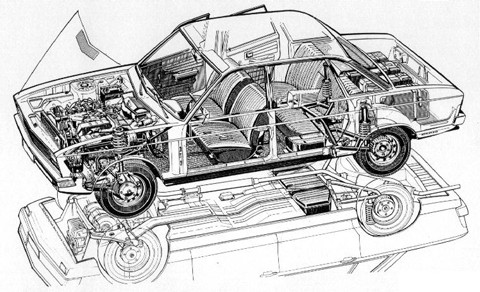
American car enthusiasts commonly think of the Golf (formerly, and yet again U.S. Rabbit) and Jetta as Volkswagen’s first cars with water-cooled engines and front wheel drive. But they didn’t start the era. In fact, it began with a car basically unknown to the American audience. Its name was K 70. Don’t expect to see a resurgence of this car on the “retro” market; it lacks the cutesy appeal of the Mini-Cooper, or the seeming built-in Beach Boys soundtrack that accompanies the New Beetle. But there’s still a following in Europe for the “Little K”, as it’s sometime called, with enthusiasts gathering in clubs as well as participating at oldtimer races and competitions. Depending on engine and equipment, the oldtimer market price for a K 70 in very good condition is currently somewhere between $3,600 to 4,300.
The car was actually engineered by the German car manufacturer NSU. 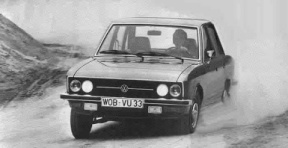 This company pioneered in the production of motorbikes in 1901 and started producing their own cars in 1906. (NSU referred to the company’s hometown, Neckarsulm, in southern Germany ). The company was famous for its avant-garde Ro 80 in the 60’s early 70’s, which was equipped with a Wankel rotary engine and targeted at the luxury segment.
This company pioneered in the production of motorbikes in 1901 and started producing their own cars in 1906. (NSU referred to the company’s hometown, Neckarsulm, in southern Germany ). The company was famous for its avant-garde Ro 80 in the 60’s early 70’s, which was equipped with a Wankel rotary engine and targeted at the luxury segment.
NSU also produced the Prinz, a boxy, sporty subcompact with rear engine--an early predecessor to the Audi TT. As a mid-sized sedan, the K 70 (“K” for “Kolben”--“piston”) was supposed to fill the gap. However, these plans ended when NSU was taken over by VW in 1969. During that time VW found itself at a conceptual dead end with its own air-cooled, boxer engine platforms. The K 70, as a “dowry”, was a chance to head in a different direction. Without major re-engineering, VW released it in 1970 as its own.
Volkswagen had the middle class segment in mind when they launched the K 70. The VW 411/412 (Type 4) with air-cooled boxer engine and the Audi 100 were already established in that market. Nonetheless, VW accepted possible ‘internal’ competition. The typical buyer of a K 70 would nowadays be looking at an Audi A6; aware of a VW Passat as the economic alternative. Dealerships at that time were longing for the K 70 as an opportunity to sell to a more upscale market than the (old) Beetle or its slightly larger Type 3 derivatives, VW 1500/1600 (sold here as Notchback, Squareback, and Fastback).
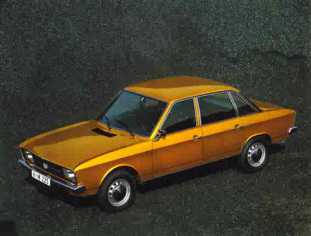 The K 70 was produced solely as a four door squareback in the tradition of the “brick-atop-a-brick” design . The hood, unconventionally, was hinged up front, opening right below the windshield, which was the only considerably slanted piece of glass. The side windows were almost straight, protecting the passengers from excessive sun impact and allowing for ample head room. The upright seating position, the low belt line and the large glass sections created a panoramic view all around. Thanks to the relatively long wheel base, the passenger compartment was spacious and leg-friendly.
The K 70 was produced solely as a four door squareback in the tradition of the “brick-atop-a-brick” design . The hood, unconventionally, was hinged up front, opening right below the windshield, which was the only considerably slanted piece of glass. The side windows were almost straight, protecting the passengers from excessive sun impact and allowing for ample head room. The upright seating position, the low belt line and the large glass sections created a panoramic view all around. Thanks to the relatively long wheel base, the passenger compartment was spacious and leg-friendly.
Foreshadowing the current standard of folding rear seats, the rear assembly could be unbolted quickly and taken out, thus, opening up an enormous cargo space with no metal wall between trunk and passenger compartment. The trunk opening, though big, did not reach down to the bumper level, making it a bit hard to load certain items, like long boards. The fully reclining front seats solved this problem to some extent, allowing long pieces to push straight up to the dash. The trunk capacity in itself, however, was already huge to begin with, given the square design. As a consequence, the aerodynamic properties were more than wanting, with tests resulting in collapsed wind tunnels, as the joke went.
The K 70 came with four cylinder engines and a manual four speed transmission only. The longitudinally mounted engines had a displacement of 1600 cc and a horsepower of 75 and 90, which translated into a top speed of 148 and 160 km/h (92/100mph). Later an 1800 cc version was launched with 100 hp.
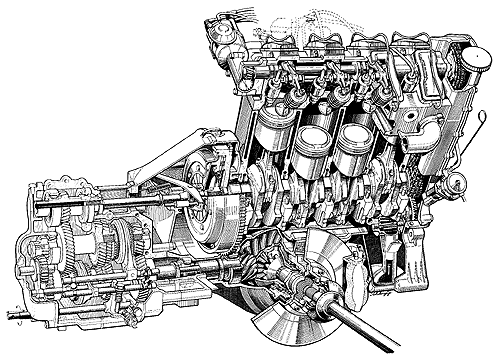
NSU had bestowed a modern engine design: the dual chain driven overhead camshaft was located in a crossflow alloy cast cylinder head actuating the opposed intake and exhaust valves over a twin rocker-arm assembly. The eight separate gold-colored galvanized valve covers were a visual delight. The coolant-heated intake manifold was fed by a double-barrel sidedraft Solex DDH carburetor with manually operated choke, which was substituted after the first production year by the DDHT version with automated choke system. The fuel pump was actuated by rod and excenter off the oil pump, itself a gear type pump driven via gear assembly by the crankshaft (a five main-bearing design).
The cast iron engine block with its alloy oil pan sat with its third and fourth cylinder over the front axle, right on top of the differential. This improved weight distribution and winter driveability without overdoing the weight accumulation up front (with its mass inertia problems) like the old Audis. This arrangement, however, stacked the engine/drivetrain assembly unusually high, leaving the transmission to bridge the height difference with an additional input shaft, of necessity a three shaft gear box. Very atypically, the input shaft was partially hollow and a two-piece unit: the solid part started right outside the gear box ran through the clutch, engaged with the splines of the clutch friction plate, and ended up in the needle bearing of the crankshaft. However, it was retractable into its hollow counterpart inside the transmission. This smart feature allowed the clutch to be serviced without having to remove the gear box, without even raising the car – a feature basically non existent among today’s cars.
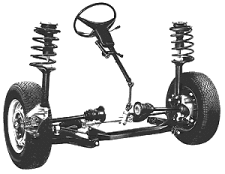
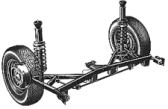 Independent front and rear suspension were not standard in those days. These components were lifted from the NSU Ro 80. The front had Mc Pherson struts with lower wishbones and a swaybar. In an attempt to reduce the unsprung weight, the front disc brakes were mounted inboard, on to the differential housing. Ensuring firmness and tight response, a rack-and-pinion steering system was chosen; unfortunately a power-assisted version was never made available. The rear suspension was equipped with semi-trailing arms, struts/shock absorber assemblies and, also, initially, a swaybar.
Independent front and rear suspension were not standard in those days. These components were lifted from the NSU Ro 80. The front had Mc Pherson struts with lower wishbones and a swaybar. In an attempt to reduce the unsprung weight, the front disc brakes were mounted inboard, on to the differential housing. Ensuring firmness and tight response, a rack-and-pinion steering system was chosen; unfortunately a power-assisted version was never made available. The rear suspension was equipped with semi-trailing arms, struts/shock absorber assemblies and, also, initially, a swaybar.
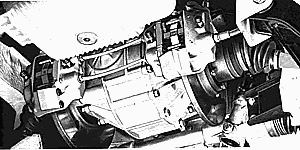 The front disc brakes had four-piston calipers and non-vented rotors. The rear was equipped with drums. The dual-circuit braking system was a diagonal layout with additional inclusion of both front calipers, which meant at least half of the braking power of both front brakes and one rear brake, respectively. This eliminated the dangerous pulling to one side of conventional one-front-brake-left diagonal systems. The braking system was power-assisted and came with a load-dependent rear brake pressure-regulating valve to control rear wheel lock-up. With all this cautious equipping, however, the rear drum brakes were rather powerful units, frequently operating at the border of overbraking.
The front disc brakes had four-piston calipers and non-vented rotors. The rear was equipped with drums. The dual-circuit braking system was a diagonal layout with additional inclusion of both front calipers, which meant at least half of the braking power of both front brakes and one rear brake, respectively. This eliminated the dangerous pulling to one side of conventional one-front-brake-left diagonal systems. The braking system was power-assisted and came with a load-dependent rear brake pressure-regulating valve to control rear wheel lock-up. With all this cautious equipping, however, the rear drum brakes were rather powerful units, frequently operating at the border of overbraking.
In the lower to mid-rev’s the K 70 drove smooth and quiet. The long wheel base contributed largely to the exceptional directional stability at all speeds. Few competitors came close. Cornering response was direct and swift. High speed cornering was no problem--no nasty surprises. Pushing the car into drift would unmistakably cause stubborn understeering.
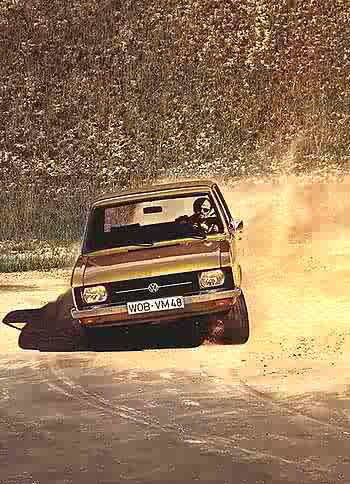 Quiet disconcerting to look at (but harmless) was the pronounced level of body-roll towards the outer curve radius – almost French-style. The brakes decelerated powerfully with an astoundingly low level of fading, given their inboard location. Large vent tubes, installed after the first production year, aided in thermal health. Suspension and brakes were completely at ease at top speeds. The engine, however, was not: It was thirsty, especially in combination with the poor aerodynamics (even a currentV8 Audi A8 gets better mileage) but most of all, the engine was rather loud and rough at high rpm’s. Its domain was cruising not racing. Nonetheless, it was used for competitions, even at Safari rallies in Africa.
Quiet disconcerting to look at (but harmless) was the pronounced level of body-roll towards the outer curve radius – almost French-style. The brakes decelerated powerfully with an astoundingly low level of fading, given their inboard location. Large vent tubes, installed after the first production year, aided in thermal health. Suspension and brakes were completely at ease at top speeds. The engine, however, was not: It was thirsty, especially in combination with the poor aerodynamics (even a currentV8 Audi A8 gets better mileage) but most of all, the engine was rather loud and rough at high rpm’s. Its domain was cruising not racing. Nonetheless, it was used for competitions, even at Safari rallies in Africa.
Given the standards of its time, the K 70 was fairly well equipped–at least if ordered with some optional packages. Of course it didn’t have all the active and passive safety features of this time, nor the flood of electronic gadgets expected nowadays. The 1960’s were still marked, for instance, by heating systems depending on the belt-driven cooling fan of the rear engine, like the air-cooled VW’s. Thus, the K 70 was the first VW product with a heating/venting system that is still the standard: a heater core that is hooked up to the engine’s coolant system, and an electric blower that dissipates the heat through blowing air from the outside over the fins of the heater core into the passenger compartment by using various vent openings. The valve regulating the hot coolant had an internal thermostat to steady the heater core temperature in case of changing engine speeds. To allow for a constant air flow, vent openings in the rear with one-way flaps were installed for the air to exit, first in the C-pillars later in the rear doors, designed to create just enough swirl to assist to keep the rear window from fogging. An air conditioning system, however, was never offered.
The K 70 came with the modern, much more efficient three-phase type alternator, first with external mechanical regulator, then with an integrated electronic one.
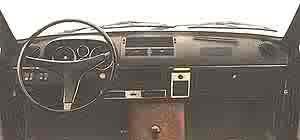 The dash had round instruments grouped together under an oval visor, which included tachometer, speedometer, fuel and coolant temperature, warning lamps and clock. Halogen headlights were available, as H4 (then the new industry standard) or as H1 with high and low beam being separate headlight units. Also, radial tires were standard: 165mm wide, on 14 inch rims (alloys optional).
The dash had round instruments grouped together under an oval visor, which included tachometer, speedometer, fuel and coolant temperature, warning lamps and clock. Halogen headlights were available, as H4 (then the new industry standard) or as H1 with high and low beam being separate headlight units. Also, radial tires were standard: 165mm wide, on 14 inch rims (alloys optional).
The K 70 did well regarding active and passive safety issues and crash ratings. The gas tank was mounted underneath the rear seats, away from collision areas. A collapsible/retractible steering column was standard, as well as safety belts for the front seats (an emerging standard/legal requirement at its time) with headrests being optional, as well as a heated rear window.
The K 70 was sold all over Europe, and in Britain, of course, as a right-hand-drive version. It was never marketed in North America but interestingly it was shipped to places like Australia, Japan and even countries with tropical climates.
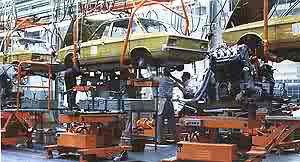 So what happened to the K 70? Volkswagen never made a commitment to integrate its inheritance from NSU into its own production line. This ensured that production costs would be quite high. In comparison, the first Passat (sold in the U.S. as “Dasher” and being actually an Audi 80 spin-off) was far cheaper to manufacture. Model improvement and technological upgrading ended finally on the backburner, with the production ceasing after some five years and over 200,000 units produced. But believe it or not, VW/Audi is still supplying spare parts and offering service.
So what happened to the K 70? Volkswagen never made a commitment to integrate its inheritance from NSU into its own production line. This ensured that production costs would be quite high. In comparison, the first Passat (sold in the U.S. as “Dasher” and being actually an Audi 80 spin-off) was far cheaper to manufacture. Model improvement and technological upgrading ended finally on the backburner, with the production ceasing after some five years and over 200,000 units produced. But believe it or not, VW/Audi is still supplying spare parts and offering service.
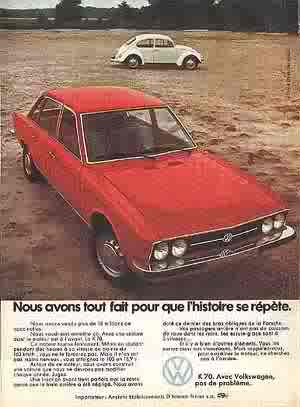 And servicing it did need, as I well remember: On a family trip through Greece and Turkey, the fuel pump of our 1974 K 70 started to slowly break down. Leaving Athens, the car began running unevenly and hesitating at all speeds except idle. First, it felt like a carburetor clogging issue. A fuel pump with too little output but still operating is hard to diagnose by pulling off the fuel hose and cranking the engine. Measuring the fuel pressure wasn’t an option, of course. So we decided to simply go on. Refueling helped a bit, because, as it later turned out, the relatively cold gasoline pumped up from below had a short term remedy impact on the pump. Thus, we made it safely to Istanbul. On the way back, however, crossing Bulgaria, things got serious. A Communist Balkan state in the late 70’s, we knew, was not likely to be well-stocked with engine parts, let alone car dealerships. Approaching Sofia, a collection of dreary Stalinist-style bunkers, the engine hesitated heavily and finally stalled. Providentially, we were close to a gas station. We pushed the car into the station and filled it up, but by now it would no longer start. The diagnosis was now simple: the fuel hose was completely dry, the clear-glass fuel filter wasn’t clogged , which left only the fuel pump to be the cause.
And servicing it did need, as I well remember: On a family trip through Greece and Turkey, the fuel pump of our 1974 K 70 started to slowly break down. Leaving Athens, the car began running unevenly and hesitating at all speeds except idle. First, it felt like a carburetor clogging issue. A fuel pump with too little output but still operating is hard to diagnose by pulling off the fuel hose and cranking the engine. Measuring the fuel pressure wasn’t an option, of course. So we decided to simply go on. Refueling helped a bit, because, as it later turned out, the relatively cold gasoline pumped up from below had a short term remedy impact on the pump. Thus, we made it safely to Istanbul. On the way back, however, crossing Bulgaria, things got serious. A Communist Balkan state in the late 70’s, we knew, was not likely to be well-stocked with engine parts, let alone car dealerships. Approaching Sofia, a collection of dreary Stalinist-style bunkers, the engine hesitated heavily and finally stalled. Providentially, we were close to a gas station. We pushed the car into the station and filled it up, but by now it would no longer start. The diagnosis was now simple: the fuel hose was completely dry, the clear-glass fuel filter wasn’t clogged , which left only the fuel pump to be the cause. 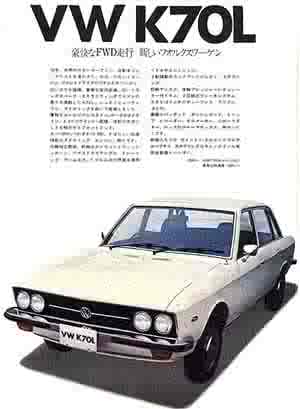 As we considered our options, we were approached by a number of locals who seemed to spend their days hanging out by the station. Surviving in a country used to “improvisation”, they decided that our car could make it. All that was needed was a ‘special’ treatment, which they offered to prove to us. They poured cold water over the pump body for a minute or two and then one of them started to suck at the fuel hose while cranking the engine. And after a little bit, the pump did indeed resume work. We were grateful, presented them with a small gift, and made it back home to Germany. But there the pump was replaced. After all you don’t want to tempt fate.
As we considered our options, we were approached by a number of locals who seemed to spend their days hanging out by the station. Surviving in a country used to “improvisation”, they decided that our car could make it. All that was needed was a ‘special’ treatment, which they offered to prove to us. They poured cold water over the pump body for a minute or two and then one of them started to suck at the fuel hose while cranking the engine. And after a little bit, the pump did indeed resume work. We were grateful, presented them with a small gift, and made it back home to Germany. But there the pump was replaced. After all you don’t want to tempt fate.

